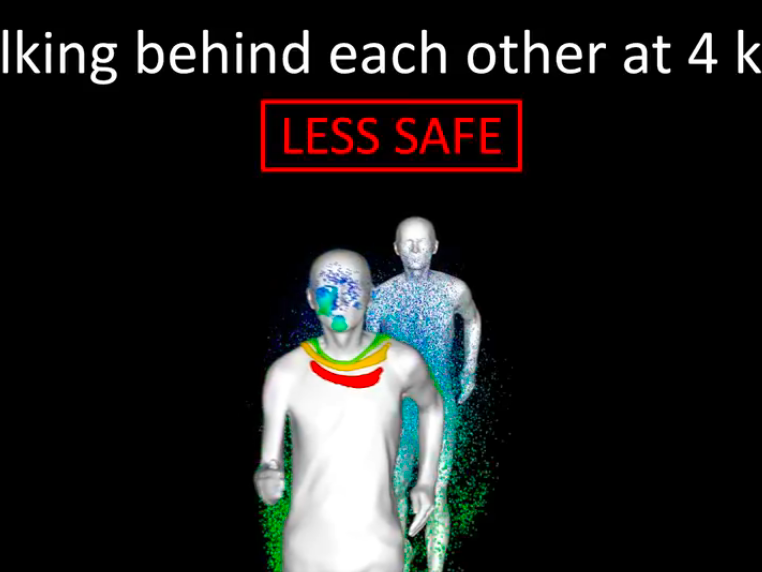This website uses cookies so that we can provide you with the best user experience possible. Cookie information is stored in your browser and performs functions such as recognising you when you return to our website and helping our team to understand which sections of the website you find most interesting and useful.

Walkers, runners and cyclists should avoid the “slipstream” of other members of the public to practise safe social distancing during the coronavirus pandemic, according to research, amid criticism that it should not have been published without peer review.
Analysis of exhaled droplets in wind tunnels, conducted by universities in Belgium and Netherlands, concluded that the typical guidance to keep 2m apart is “very effective” when standing still, either indoors or in calm weather, but is inadequate when exercising in the direct path of other members of the public.
The paper, entitled Social Distancing v2.0: During Walking, Running and Cycling, found walkers should keep at least 4m clear when following others, runners should stay 10m from one another other, and fast cyclists should ride as much as 20m apart, in order to avoid passing through “droplet clouds” from others exercising.
“The slipstream is the zone that arises right behind a person when they are walking or cycling, and which pulls the air a bit along with this moving person, as it were,” said Professor Bert Blocken, who led the research. “Cyclists like to position themselves in the slipstream of others to reduce their air resistance. But someone who walks or runs also has such a slipstream. We have seen that no matter how that zone forms, droplets end up in that air stream. So it’s best to avoid that slipstream.”
However the white paper, published by Eindhoven University of Technology and KU Leuven in Belgium, has come under criticism, having not yet been peer reviewed. Blocken said the paper was rushed into the public domain because the authors considered it “unethical” to hold back results from the public for several months.
Dr Bill Hanage, associate professor at Harvard’s Center for Communicable Disease Dynamics, told The Independent that the study was “not really useful to epidemiologists” as “the amount of transmission from this route even if it is possible will be dwarfed by that from others”.
Dr Hanage said: “I do wish people would quit this kind of thing. The bit in their white paper about a ‘modest contribution…’ [ to help the fight against Covid-19] makes my blood boil. On the epidemiology side – where the droplets are is much less relevant than the amount of transmission that occurs via this route. And [there is no analysis in the paper of] viral load. Advice on physical distancing is really about reducing the risk of transmission rather than eliminating it altogether.”
Professor Blocken stressed that the research was carried out by aerodynamic experts, rather than virologists, and that it therefore evaluated only the likelihood of someone passing through a “particle cloud”, and never claimed to assess the actual risk of infection.
Speaking to The Independent, Professor Blocken defended his research, saying: “Some people think this all comes out of the blue,” he said, “but these are experiments I’ve been running for 20 years.
“It’s interesting to see studies can easily be misinterpreted. Most people understood the message in a positive way, but there were two misconceptions. One misconception is that we make statements on virology. We only tested distance to the exposure of droplets. That’s aerodynamics,: how do droplets behave in the airflow? I didn’t make any claims that infection rates would be higher or lower.
“And some people have said that I advised against going outside, running or cycling, which is the opposite of my intention. I am a keen cyclist myself. They should go out, but they should be careful. If you move too close to another person, stay out of their slipstream, but if you want to be in slipstream, keep a longer distance.”
While the research encouraged keeping fit “to ease one’s mind in times of Covid-19”, it advised exercising in a staggered formation to avoid the direct slipstream of others, and to ensure a wide berth when overtaking.
“If someone exhales, coughs or sneezes while walking, running or cycling, most of the microdroplets are entrained in the wake or slipstream behind the runner or cyclist,” said Professor Blocken. “The other person who runs or cycles just behind this leading person in the slipstream then moves through that cloud of droplets.”
He added: “If you want to overtake someone, it is also recommended to start ‘pre‐sorting’ into a staggered arrangement from a fairly long distance – 20m with bicycles, for example, so that you can overtake carefully and at a proper distance by moving in a straight line.”



 Africana55 Radio
Africana55 Radio 

